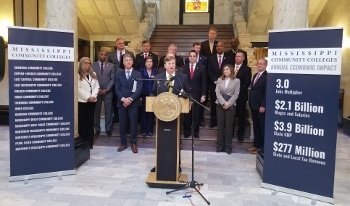An economic impact study, commissioned by the Mississippi Association of Community and Junior Colleges (MACJC), analyzed the contributions of Mississippi’s community colleges to the state’s economy. The findings of that study have been released.
The report, prepared by the National Strategic Planning and Research Center at Mississippi State University, had three primary objectives: (1) examine who is served by the statewide network of community colleges, (2) determine education and labor market related outcomes of those served, and (3) estimate the overall impact of community colleges to the state of Mississippi.
According to the “Investing in Mississippi” impact report, community colleges in Mississippi provide $2.1 billion in wages and salaries, $3.9 billion in state gross domestic product (GDP), and $277 million in state and local tax revenues.

Governor Tate Reeves said, “One of the things I believe, is there is no denying that work is changing. It’s changing here in Mississippi, and it’s changing across the country. The jobs that paid well fifty years ago, are not necessarily the jobs that pay well today.”
Reeves continued by saying, “We know for a fact that skilled trades are soaring. Mississippi’s economy depends on highly skilled people who are working and contributing across our great state. Both employers and employees are the key to that success.”
“The jobs, the careers, the opportunities, are here” said Reeves. “We will continue growing and developing career opportunities as companies expand and invest more capital in our state. But to ensure this happens, we must invest in state resources where we can demonstrate a return on investment and have a real impact on people’s lives.”
In closing, Governor Reeves said, “Our community colleges are woven into the fabric of each community. No one knows better which jobs are available, what skills are needed to equip workers, and most importantly, how to prepare them.”
Each county in Mississippi is served by the state’s community college network. The report states that each year, an average of 100,000 students are served through academic credential and degree programs. More than 100,000 are served through non-credit workforce training.
Dr. Jesse Smith, President of Jones Community College and Legislative Committee Chair of the MACJC said, “Understanding the value of public education and workforce training has historically been challenging, until now.”
Smith said, “We intend to show legislators, county officials and the citizens of Mississippi how critical community colleges are for the successful future of the State of Mississippi. Specifically, we can make a reasonable assumption on the return on investment to the State of Mississippi and the potential for increased earnings for the student who earns a community college degree or workforce credential.”
Marilyn Ford, President of the Mississippi Faculty and Staff Association and English Instructor at East Mississippi Community College, says, “The data represents a community of living, breathing, hopeful individuals.”
The study also revealed:
• 96 percent of community college students are Mississippi residents.
• More than two-thirds of Mississippi college-bound public high school graduates enter community colleges within one year of graduation.
• Nearly 81,000 Mississippians are trained each year in community college non-credit workforce programs, supporting the creation of 1,240 additional jobs.
• On average, 8,876 Mississippi community college graduates enter the Mississippi workforce every year. These graduates support an additional 6,421 jobs, create $509 million in wages and salaries, $73 million in state and local tax revenue and contribute $1.2 billion to the state’s Gross Domestic Product.
• Of the approximately 13,000 undergraduates awarded degrees annually from public four-year universities in Mississippi, about 58 percent previously attended a Mississippi community college.







